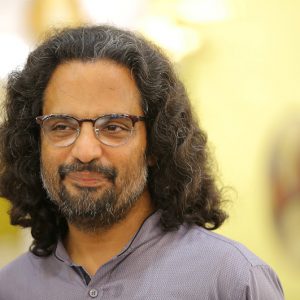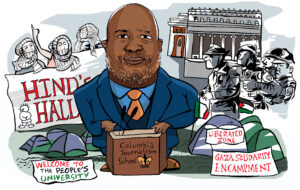
When contesting repressive laws makes you a dangerous citizen: A profile of Rona Wilson

“At no time have governments been moralists. They never imprisoned people and executed them for having done something. They imprisoned and executed them to keep them from doing something. They imprisoned all those prisoners of war, of course, not for treason to the motherland…They imprisoned all of them to keep them from telling their fellow villagers about Europe. What the eye doesn’t see, the heart doesn’t grieve for.”
― Aleksandr Solzhenitsyn, The Gulag Archipelago, 1918-1956
‘Political Prisoner’ is a category of criminal offense that sits most egregiously in any civilized society, especially in countries that call themselves liberal democracies. It is a thought crime: the crime of thinking, acting, speaking, probing, reporting, questioning, demanding rights, and, more importantly, exercising one’s citizenship. But these inhumane incarcerations do not just target private acts of courage, they are bound together with the fundamental questions of citizenship, and with people’s capacity to hold the State accountable. Especially States that are unilaterally and fundamentally remaking their relationship with their people. The assault on the fundamental rights has been consistent and ongoing at a global level and rights-bearing citizens are transformed into consuming subjects of a surveillance State.
In this transforming landscape, dissent is sedition, and resistance is treason.
While the Indian State has a long history of ruthlessly crushing dissent, a new wave of arrests began in 2018. Eleven prominent writers, poets, activists, and human rights defenders have been in prison, held under the Unlawful Activities (Prevention) Act. They are accused of being members of a banned Maoist organization, plotting to kill Prime Minister Narendra Modi, and inciting violent protests in Bhima Koregaon. To date, no credible evidence has been produced by the investigating agency, and those accused remain incarcerated without bail. Since the anti-Citizenship Amendment Act protest began in December 2019, students, activists, and peaceful protesters have been charged with sedition, targeted with violence, and subjected to arrests. Since then, more arrests have followed specifically targeting local Muslim students leader and protestors, including twenty-seven-year-old student leader Safoora Zargar, who is currently pregnant.
Since the COVID-19 lockdown was announced, India’s leading public intellectuals, opposition leaders, writers, thinkers, activists, and scholars have written various appeals to the Narendra Modi government for the release of India’s political prisoners. They are vulnerable to COVID-19 contagion in the country’s overcrowded jails, where three coronavirus-related deaths have already been reported. In response, the State has doubled down and rejected all the bail applications. It also shifted the seventy-year-old journalist Gautham Navlakha from Delhi’s Tihar Jail to Taloja, without any notice or due process – Taloja is one of the prisons where a convict has already died of COVID-19.
A fearful, weak State silences the voice of dissent. Once it has established repression as a response to critique, it has only one way to go: become a regime of authoritarian terror, where it is the source of dread and fear to its citizens.
How do we live, survive, and respond to this moment?
In collaboration with maraa, The Polis Project is launching Profiles of Dissent. This new series centers on remarkable voices of dissent and courage, and their personal and political histories, as a way to reclaim our public spaces.
Profiles of Dissent is a way to question and critique the State that has used legal means to crush dissent illegally. It also intends to ground the idea that, despite the repression, voices of resistance continue to emerge every day.
You can read Varavara Rao’s profile here, the profile of Sudha Bharadwaj here, that of GN Saibaba here, Gautham Navlakha’s profile here, Anand Teltumbde here, Sharjeel Usmani here, Shoma Sen here, Surendra Gadling here, and Asif Iqbal Tanha here.
RONA WILSON

Rona Wilson, a forty-seven-year-old activist from Kollam district in Kerala, has made Delhi his second home since the late 1990s. Having come to the capital during his post-graduation, Wilson almost immediately took to activism.
Rona Wilson is a member of the Committee for the Release of Political Prisoners (CRPP), which has campaigned against the UAPA and other repressive laws.
Wilson works towards arranging legal-aid for political prisoners. His work includes raising awareness of work by political prisoners, fact- checking of lies and propaganda as well as constructing a counter narrative to the dominant development ideology.
Date of arrest: 6 June 2018
Charges: Rona Wilson’s house in south Delhi was raided in a nation-wide crackdown. This led to his arrest alongside five other activists. They were charged under UAPA, allegedly for instigating violence through the Elgaar Parishad during the Bhima Koregaon celebration on 1 January 2018. Letters allegedly found at his house—which the police provided to the press—also revealed a “Maoist plot to assassinate Prime Minister Modi”. The letter was allegedly found on activist Rona Wilson’s computer. Since being released to the press, the letter has been severely criticized for being a combination of both commonly-known and insubstantial information.
Update: On 24 October 2018, the Bombay High Court quashed a Pune court ruling that had granted more time to the police to file a charge sheet against Wilson. Charge sheets were finally filed on 15 November and again on 4 December 2018. Justice Bhatkar’s verdict paved the way for Wilson and the other activists arrested on 6 June 2018to apply for bail. Wilson’s bail hearing was fixed for 14 November 2018 but has now been postponed to 11 December 2018 by the Supreme Court.
Update 7 September 2020: Rona Wilson has been denied bail several times since 2018.
Location of work: Delhi
******
Transcription of a speech, “The history of criminal laws in India”, delivered by Rona Wilson
The Committee for the Release of Political Prisoners is getting reconvened and rejuvenated with a new set of people. Apart from that, we have been planning
on taking up a major campaign. We have decided on the four main aspects we want to put forward before the people of the subcontinent. Number 1: release all political prisoners, unconditionally. Number 2: repeal all draconian laws including AFSPA and UAPA. Number 3: remove all armed forces from people’s struggle areas. These are the initial three slogans we decided a year before. Now with the new developments, we feel like another slogan should be incorporated. This new development is the decision to start a National Counter-Terrorism Center. We have to initiate a mass movement to see to it that the National Counter Terrorism Center does not get implemented along with the National Investigation Agency (another structure which is being formulated).
Given the situation that is prevalent in the subcontinent, repression is a necessary condition for the Indian state to perpetuate/ reproduce itself. I want to begin with these important slogans as one premise that the CPRR is based on. Given the situation that is prevalent in the subcontinent, repression is a necessary condition for the Indian state to perpetuate/ reproduce itself. Given the premise that repression is the necessary condition to reproduce the Indian state, we believe that if we map the evolution of the various repressive laws whether, in the Indian Penal Code or the Criminal Procedure Code (CrPC), we can see that when these laws are questioned or there are protests against them by mass people movements, they are re-interpreted and brought back under a new name or label. These new laws return with even more draconian instruments, as per the need of the state and its circumstances.
Prior to the inception of the Constitution of the Indian state from 1942 onwards, we can see the Armed Forces Special Powers Act (AFSPA) being implemented in the region of the Northeast. This was in anticipation of the emerging people’s struggles for self- determination. The Manipuri people, the Nagas—all of whom were demanding independence. In fact, they had declared themselves independent even before the independence of the Indian state in 1947. These demands were being realized through ‘on the ground’ people’s movements. To control these movements and prevent these demands from being realized AFSPA was enforced. Enforced in 1942 by the British colonial government, the act was enforced with more venom in 1958 by the Government of India. The act was applied to the whole state of Assam, Manipur, Meghalaya, Nagaland, Tripura, and the Union territories of Arunachal Pradesh and Mizoram. Later it was extended to Kashmir. AFSPA empowered the armed forces to kill anyone with impunity on real suspicion that the person was going to commit certain offenses.
The same act was copied verbatim in the Maintenance of Internal Security Act (MISA) 1971, under which tens of thousands of people were arrested between 1970-1973 in West Bengal alone. From those arrested the majority was comprised of Naxalites. Prior to the emergency (1975–1977) thousands of people (mostly Naxalites) were shot at or maimed in attacks. By the end of the emergency, MISA had become the most hated word and hence MISA was copied into and replaced by the National Security Act (NSA) 1980. In fact, there is no end to MISA. The act ended up having numerous regional and national applications. For example – West Bengal Prevention of Violent Activities Act; Punjab Disturbed Areas Ordinance; National Security Act (NSA) 1980; Terrorism and Disruptive Activities (Prevention) Act (TADA) 1985; Prevention of Terrorism Act (POTA) 2002; the Public Security Act in Kashmir; and numerous other acts and ordinances were passed. One can see the progression, the repetition, the replication of the same law as per the needs of the state.
At times we tend to make the distinction that during the Nehruvian period things were much better.
However, we can see that all these acts were promulgated at that time. The period was a moment in the history of the subcontinent where much bloodshed and state-building took place. Where the Indian state was constituted through armed occupation in several areas as well as by bringing in the police and necessary security in several regions to ensure that the state became well entrenched. Moving forward to the 1980s and 1990s—liberalization, privatization, and globalization policies are being implemented. During this period the laws are being re-invented and implemented with ferocity. As outcries and protests against the laws (due to mass imprisonments) take place, the law TADA is repealed but is immediately replaced by a similar act POTA. When POTA becomes a hated word, it is replaced by the UAPA, which was created in 1967 but strengthened further
as a replacement.
The picture now becomes complete with the National Counter-Terrorism Center. This center gains its strength from the UAPA. The picture becomes complete as its implementation means that we are now moving into a national security stage. Through the UAPA, the National Counter-Terrorism Center as well as the Information and Broadcasting Ministry gains the power to investigate individuals in secret as well as arrest those whom they deem as carrying out activities which are not in the interest of the Indian state. Mind you, the definition of terrorism under the UAPA is the vaguest definition that can be kept so that anyone who the state believes is a threat can be arrested under the act.
At the present juncture, one can notice that there is more and more civil expenditure going into the building of structures like state-of-the-art prisons, several nodal centers, and apart from all this we also see numerous unknown expenditures to create a war-time economy. At the present juncture, one can notice that there is more and more civil expenditure going into the building of structures like state-of-the-art prisons, several nodal centers, and apart from all this we also see numerous unknown expenditures to create a war-time economy. By this I mean, for example, if you go to the Northeast (Naga areas, Manipur) or, for that matter, Kashmir, you have an emergency situation. This is because there is an impetus from the government to build up the so-called security apparatus from the point of view of public safety. Here when one creates a security situation, money can be spent on security institutions and structures which allows a new industry to thrive. If you go to universities today you can find CCTV.
What is the purpose of CCTV in classrooms? What is the purpose of CCTV in staff rooms? The security industry is thus allowed to be built in a big way. What is the purpose of CCTV in classrooms? What is the purpose of CCTV in staff rooms? The security industry is thus allowed to be built in a big way. The money being pumped in creates a buffer section in places like the Northeast or Kashmir due to the creation of a security-based economy allowing the security industry to benefit. The prevalence of certain polarisations in society is used to create this buffer. Within the buffer, the material consumption is able to thrive by the affluent middle class who thus also become beneficiaries of the war-time economy. This gets replicated in areas like North Telangana where emergency-type situations can be manufactured through the development of security infrastructure as well as the informal network within the buffer zone. This is part of the securitized state. If one looks through the papers, such situations have become normalized. There is no one to question why so much money is being spent. There is no one to question the spending of money on this informal network. There is no one to question why an emergency situation is deliberately created in region like the Northeast and Kashmir, which are primed for the security industry to survive.
The role of the media is very important in understanding this normalization.
There is no one to question why an emergency situation is deliberately created in regions like the Northeast and Kashmir, which are primed for the security industry to survive. Before any person is tried for questioning the state and voicing their dissent, the media host insidious, insinuating trials. It is here that the entire public opinion, public consent is manufactured towards ensuring that a particular detainee can be subjected to whatever the state wishes to do. To give dissenters “the right treatment.” It is from this point that our campaign becomes important. The four slogans I spelt out are important. For us, we know that when a political prisoner is detained we need to provide legal expertise and assistance to ensure their fundamental rights are protected. However, beyond that the CRPP’s role becomes important from the perspective of generating the public opinion. When I say this, I know well that it is not an easy task for us. The generating of public opinion comes against the huge apparatus of state propaganda, state-owned media as well as privately-owned media, who all have similar interests. For example: mining interests, interest in building dams, policies to loot and plunder.
A certain section of the media also has similar interests. Moreover, there is a convergence of interests between what the state wants to do as part of circulation of the policies of liberalization, privatization, and globalization as well as what the media would want to generate as a profile that is desirable for the people of the subcontinent. Given that convergence, the campaign which CRPP wants to carry out, becomes very difficult. We have to a mass agitation to change public opinion on these matters. We have to create a mass movement to combat the deliberately created narratives put forward by the state.
We have to create counter profiles — why is it that a Muslim is always viewed as aggressive? Why is the Kashmiri Muslim always viewed as a terrorist who cannot be believed? Why are the Nagas viewed as people who can be given a secondary status? Why is the Maoist always viewed as a terrorist? Why is it that the Maoist should not be given justice? This deliberate profile created by the media and government creates a fear among the people. We have to create counter profiles — why is it that a Muslim is always viewed as aggressive? Why is the Kashmiri Muslim always viewed as a terrorist who cannot be believed? Why are the Nagas viewed as people who can be given a secondary status? Why is the Maoist always viewed as a terrorist? Why is it that the Maoist should not be given justice? This deliberate profile created by the media and government creates a fear among the people. Furthermore, this fear is created among people to prevent them from speaking out. We have to break that silence. Breaking that silence requires us to come out and reveal exactly what is happening and what are silenced demographic actually facing. For example—what is it really like for the tribals in Bastar when they are standing up against the massive machinery of the state, the corporates and the imperialists? What does it mean for the everyday lives of people who live there? What does it mean when they are talking about a new world? What does it mean when they are talking about taking their own futures in their own hands? That is precisely where the whole question of justice, the whole question of justice based on self-reliance becomes important. This is why it is important the CRPP moves towards creating an agitation, a movement to present the alternative narrative which exists in opposition to the state.





